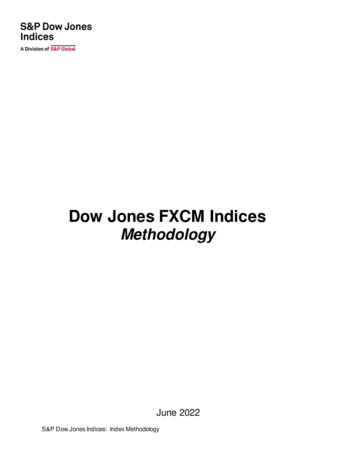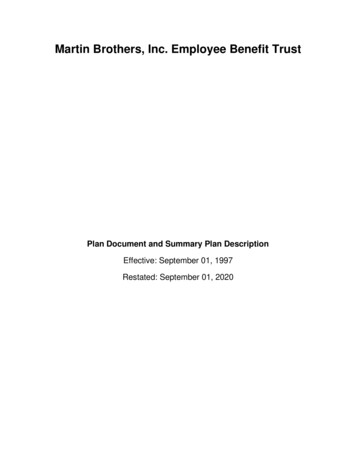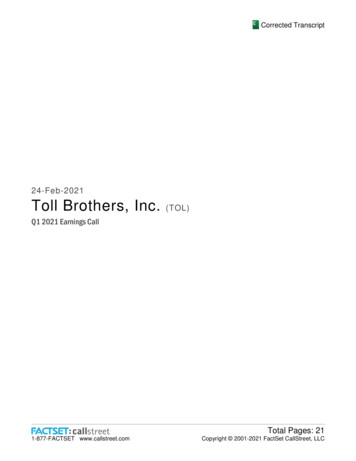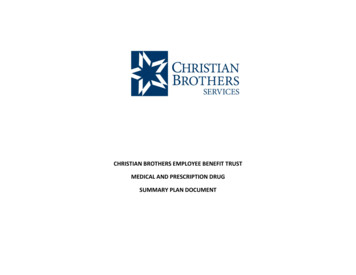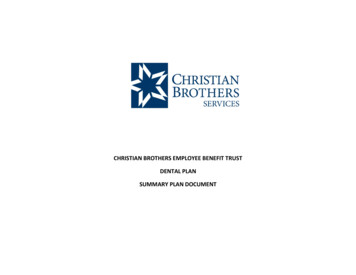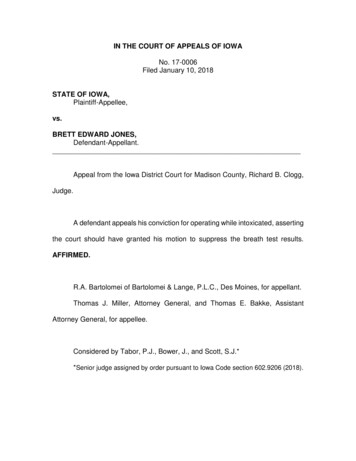
Transcription
Solutions Manual for Essentials of Business Analytics 2nd Edition by CammFull Download: -camm/02 EBA2eSolutionsChapter2.pdf02 EBA2e Case Soln Chapter2.pdfFull all chapters instant download please go to Solutions Manual, Test Bank site: downloadlink.org
Descriptive StatisticsChapter 2Descriptive lc.Categoricald.Quantitativee.Categoricala.The top 10 countries according to GDP are listed below.CountryContinentUnited StatesNorth Europe3,577,031FranceEurope2,776,324BrazilSouth America2,492,908United ia1,850,401CanadaNorth America1,736,869b.3.GDP (millions of US )15,094,025The top 5 countries by GDP located in Africa are listed below.CountryContinentSouth P (millions of US )The sorted list of carriers appears below.CarrierPrevious YearOn-timePercentageCurrent YearOn-timePercentageBlue Box Shipping88.4%94.8%Cheetah LLC89.3%91.8%Smith Logistics84.3%88.7%Granite State Carriers81.8%87.6%2-1
Descriptive StatisticsSuper Freight92.1%86.8%Minuteman Company91.0%84.2%Jones Brothers68.9%82.8%Honsin Limited74.2%80.1%Rapid Response78.8%70.9%Blue Box Shipping is providing the best on-time service in the current year. Rapid Response isproviding the worst on-time service in the current year.4.b.The output from Excel with conditional formatting appears below.c.The output from Excel containing data bars appears below.d.The top 4 shippers based on current year on-time percentage (Blue Box Shipping, Cheetah LLC,Smith Logistics, and Granite State Carriers) all have positive increases from the previous year andhigh on-time percentages. These are good candidates for carriers to use in the future.a.The relative frequency of D is 1.0 – 0.22 – 0.18 – 0.40 0.20.b.If the total sample size is 200 the frequency of D is 0.20*200 40.c. and d.ClassARelative FrequencyFrequency% Frequency0.2244222-2
Descriptive 00100These data are BBT1428THM612WoF1326Total50100c.The largest viewing audience is for The Big Bang Theory and the second largest is for Wheel ofFortune.a.Least 12, Highest 23b.PercentHours in Meetings 19-20520%21-22416%23-24416%25100%2-3Frequency
Descriptive -2021-2223-24Hours per Week in MeetingsThe distribution is slightly skewed to the left.7.a.Industry8.Frequency% ction2814%Total200100%b.The cellular phone providers had the highest number of complaints.c.The percentage frequency distribution shows that the two financial industries (banks and collectionagencies) had about the same number of complaints. Also, new car dealers and cable and satellitetelevision companies also had about the same number of complaints.a.Living AreaCitySuburbSmall TownRural AreaTotalLive Now32/100 32%26/100 26%26/100 26%16/100 16%100%Ideal Community24/100 24%25/100 25%30/100 30%21/100 21%100%2-4
Descriptive StatisticsWhere do you live now?35%30%Percent25%20%15%10%5%0%CitySuburbSmall TownLiving AreaRural AreaWhat do you consider the ideal mall TownIdeal CommunityRural Areab.Most adults are now living in a city (32%).c.Most adults consider the ideal community a small town (30%).d.Changes in percentages by living area: City –8%, Suburb –1%, Small Town 4%, and Rural Area 5%.Suburb living is steady, but the trend would be that living in the city would decline whileliving in small towns and rural areas would increase.2-5
Descriptive 231024-269Total:40b.ClassRelative FrequencyPercent 10.ClassFrequency10-1910Cumulative Frequency1020-29142430-39174140-4974850-5925011. a – otal:201.00Classe.From the cumulative relative frequency distribution, 60% of customers wait 9 minutes or less.2-6
Descriptive Statistics12. 8642013.14.b.The distribution is slightly skewed to the right.c.The most common score for students is between 1400 and 1600. No student scored above 2200, andonly 3 students scored above 1800. Only 4 students scored below 1200.a.Mean 15 or use the Excel function AVERAGE.5To calculate the median, we arrange the data in ascending order:10 12 16 17 20Because we have n 5 values which is an odd number, the median is the middle value which is 16or use the Excel function MEDIAN.b.Because the additional data point, 12, is lower than the mean and median computed in part a, weexpect the mean and median to decrease. Calculating the new mean and median gives us mean 14.5 and median 14.10 20 12 17 16Without Excel, to calculate the 20th percentile, we first arrange the data in ascending order:15 20 25 25 27 28 30 34𝑝The location of the pth percentile is given by the formula 𝐿𝑝 (𝑛 1)10020(8 1) 1.8. Thus, the 20th percentile is 80% of the way between theFor our date set, 𝐿20 100value in position 1 and the value in position 2. In other words, the 20th percentile is the value inposition 1 (15) plus 0.80 time the difference between the value in position 2 (20) and position 1 (15).Therefore, the 20th percentile is15 0.80*(20-15) 19.2-7
Descriptive StatisticsWe can repeat the steps above to calculate the 25th, 65th and 75th percentiles. Or using Excel, wecan use the function PERCENTILE.EXC to get:25th percentile 21.2565th percentile 27.8575th percentile 29.553 55 70 58 64 57 53 69 57 68 5315.Mean 59.727 or use the Excel function AVERAGE.11To calculate the median arrange the values in ascending order53 53 53 55 57 57 58 64 68 69 70Because we have n 11, an odd number of values, the median is the middle value which is 57 or usethe Excel function MEDIAN.The mode is the most often occurring value which is 53 because 53 appears three times in the dataset, or use the Excel function MODE.SNGL because there is only a single mode in this data set.16.To find the mean annual growth rate, we must use the geometric mean. First we note that x x2 x9 x x x9 3500 5000 1 2, so 1 0.700where x1, x2, are the growth factors for years, 1, 2, etc. through year 9.9nNext, we calculate 𝑥̅g (𝑥1 )(𝑥2 ) (𝑥𝑛 ) 0.70 0.961144.So the mean annual growth rate is (0.961144 – 1)100% -0.38856%17.For the Stivers mutual fund, x x2 x8 x x x8 18000 10000 1, so 1 2 1.8where x1, x2, are the growth factors for years, 1, 2, etc. through year 8.x n x1 x2 x8 8 1.80 1.07624Next, we calculate gSo the mean annual return for the Stivers mutual fund is (1.07624 – 1)100 7.624%.For the Trippi mutual fund we have: x1 x2 10600 5000 xg n x1 x2 x8 , so x x x 2.12 and x8 18282.12 1.09848So the mean annual return for the Trippi mutual fund is (1.09848 – 1)100 9.848%.While the Stivers mutual fund has generated a nice annual return of 7.6%, the annual return of 9.8%earned by the Trippi mutual fund is far superior.2-8
Descriptive StatisticsAlternatively, we can use Excel and the function GEOMEAN as shown below:18. ni 1 xi 1291.5 26.906a.Mean b.To calculate the median, we first sort all 48 commute times in ascending order. Because there are aneven number of values (48), the median is between the 24th and 25th largest values. The 24th largestvalue is 25.8 and the 25th largest value is 26.1.(25.8 26.1)/2 25.95Or we can use the Excel function MEDIAN.c.The values 23.4 and 24.8 both appear three times in the data set, so these two values are the modesof the commute times. To find this using Excel, we must use the MODE.MULT function.d.Standard deviation 4.6152. In Excel, we can find this value using the function STDEV.S.Variance 4.61522 21.2998. In Excel, we can find this value using the function VAR.S.e.The third quartile is the 75th percentile of the data. To find the 75th percentile without Excel,𝑝(𝑛 1) 𝐿75 we first arrange the data in ascending order. Next we calculate 𝐿𝑝 n4810075(48 1) 36.75.100In other words, this value is 75% of the way between the 36 th and 37th positions. However, in ourdate the values in both the 36th and 37th positions are 28.5. Therefore, the 75th percentile is 28.5. Orusing Excel, we can use the function PERCENTILE.EXC.19.a.The mean waiting time for patients with the wait-tracking system is 17.2 minutes and the medianwaiting time is 13.5 minutes. The mean waiting time for patients without the wait-tracking system is29.1 minutes and the median is 23.5 minutes.b.The standard deviation of waiting time for patients with the wait-tracking system is 9.28 and thevariance is 86.18. The standard deviation of waiting time for patients without the wait-trackingsystem is 16.60 and the variance is 275.66.2-9
Descriptive Statisticsc and d.e.20.Wait times for patients with the wait-tracking system are substantially shorter than those forpatients without the wait-tracking system. However, some patients with the wait-tracking system stillexperience long waits.a.The median number of hours worked for science teachers is 54.b.The median number of hours worked for English teachers is 47.c.d.2 - 10
Descriptive Statistics21.e.The box plots show that science teachers spend more hours working per week than English teachers.The box plot for science teachers also shows that most science teachers work about the same amountof hours; in other words, there is less variability in the number of hours worked for science teachers.a.Recall that the mean patient wait time without wait-time tracking is 29.1 and the standard deviation37 29.1of wait times is 16.6. Then the z-score is calculated as, 𝑧 0.48.16.6b.Recall that the mean patient wait time with wait-time tracking is 17.2 and the standard deviation of37 17.2wait times is 9.28. Then the z-score is calculated as, 𝑧 2.13.9.28As indicated by the positive z–scores, both patients had wait times that exceeded the means of theirrespective samples. Even though the patients had the same wait time, the z–score for the sixth patientin the sample who visited an office with a wait tracking system is much larger because that patient ispart of a sample with a smaller mean and a smaller standard deviation.c.To calculate the z-score for each patient waiting time, we can use the formula 𝑧 the Excel function STANDARDIZE. The z–scores for all patients follow.Without Wait-Tracking SystemWith Wait-Tracking SystemWait Time24z-Score-0.31Wait 5180.09310.1112-0.56440.90372.132 - 11𝑥𝑖 𝑥̅𝑠or we can use
Descriptive 6370.4815-0.24No z-score is less than -3.0 or above 3.0; therefore, the z–scores do not indicate the existence ofany outliers in either sample.23.24.a.According to the empirical rule, approximately 95% of data values will be within two standarddeviations of the mean. 4.5 is two standard deviation less than the mean and 9.3 is two standarddeviations greater than the mean. Therefore, approximately 95% of individuals sleep between 4.5and 9.3 hours per night.b.𝑧 c.𝑧 a.615 is one standard deviation above the mean. The empirical rule states that 68% of data values willbe within one standard deviation of the mean. Because a bell-shaped distribution is symmetric halfof the remaining values will be greater than the (mean 1 standard deviation) and half will be below(mean – 1 standard deviation). In other words, we expect that 0.5*(1 - 68%) 16% of the datavalues will be greater than (mean 1 standard deviation) 615.b.715 is two standard deviations above the mean. The empirical rule states that 95% of data values willbe within two standard deviations of the mean, and we expect that 0.5*(1 - 95%) 2.5% of datavalues will be above two standard deviations above the mean.c.415 is one standard deviation below the mean. The empirical rule states that 68% of data values willbe within one standard deviation of the mean, and we expect that 0.5*(1 - 68%) 16% of datavalues will be below one standard deviation below the mean. 515 is the mean, so we expect that 50%of the data values will be below the mean. Therefore, we expect 50% - 16% 36% of the data valueswill be between the mean and one standard deviation below the mean (between 414 and 515).d.𝑧 e.𝑧 8 6.91.26 6.91.2 0.9167 0.75620 515100405 515100 1.05 1.10a.70605040y22.302010005101520xb.There appears to be a negative linear relationship between the x and y variables.2 - 12
Descriptive Statisticsc.Without Excel, we can use the calculations shown below to calculate the covariance:xiyi(𝑥𝑖 𝑥̅ )(𝑦𝑖 𝑦̅)( xi x )( yi y 𝑥̅ 8𝑦̅ 46𝑠𝑥𝑦 (𝑥𝑖 𝑥̅ )(𝑦𝑖 𝑦̅)𝑛 1 16 8 18 70 1284 60Or, using Excel, we can use the COVARIANCE.S function.The negative covariance confirms that there is a negative linear relationship between the x and yvariables in this data set.d.To calculate the correlation coefficient without Excel, we need the standard deviation for x and y:𝑠𝑥 5.43, 𝑠𝑦 11.40. Then the correlation coefficient is calculated as:𝑟𝑥𝑦 𝑠𝑥𝑦𝑠𝑥 𝑠𝑦 60(5.43)(11.40) 0.97.Or we can use the Excel function CORREL.The correlation coefficient indicates a strong negative linear association between the x and yvariables in this data set.25. a.b.The scatter chart indicates that there may be a positive linear relationship between profits andmarket capitalization.Without Excel, we can use the calculations below to find the covariance and correlation 2.13461.412520.33547.632382.48925.39550.2( xi x )( yi y )( xi x ) 2( yi y ) 232068.0022745730.18796726743.27761839953.072 - 13( xi x )( yi y 48
Descriptive 149359 (𝑥𝑖 𝑥̅ )(𝑦𝑖 𝑦̅) 3954149359 131804978.6𝑛 130 (𝑥𝑖 𝑥̅ )2368589209.4𝑠𝑥 3505.18𝑛 130𝑠𝑥𝑦 (𝑦 𝑦̅)262647162947𝑠𝑦 45697.25𝑛 130𝑟𝑥𝑦 𝑠𝑥𝑦131804978.6 0.8229𝑠𝑥 𝑠𝑦 (3505.18)(45697.25)Or using Excel, we use the formula COVARIANCE.S(B2:B32,C2:C32) to calculate thecovariance, which is 131804978.638. This indicates that there is a positive relationship betweenprofits and market capitalization.26.c.In the Excel file, we use the formula CORREL(B2:B32,C2:C32) to calculate the correlationcoefficient, which is 0.8229. This indicates that there is a strong linear relationship between profitsand market capitalization.a.Without Excel, we can use the calculations below to find the correlation 576.9911.127.5612.114.394.785.786.0810.054.75( xi x )( yi y 407-1.5507-0.5507-0.25073.7193-1.5807( xi x ) 3430.37802 - 14( yi y ) 3.83292.4987( xi x )( yi y .68880.9719
Descriptive 290.16520.01133.23541.431525.5517 (𝑥𝑖 𝑥̅ )(𝑦𝑖 𝑦̅) 25.5517 0.9828𝑛 126 (𝑥𝑖 𝑥̅ )225.77407𝑠𝑥 0.9956𝑛 126𝑠𝑥𝑦 𝑠𝑦 𝑟𝑥𝑦 (𝑦 𝑦̅)2130.0594 2.2366𝑛 126𝑠𝑥𝑦0.9828 0.44𝑠𝑥 𝑠𝑦 (0.9956)(2.2366)Or we can use the Excel function CORREL.The correlation coefficient indicates that there is a moderate positive linear relationship between joblessrate and delinquent loans. If the jobless rate were to increase, it is likely that an increase in thepercentage of delinquent housing loans would also occur.b.Delinquent Loans (%)141210864204567Jobless Rate (%)2 - 158910
Chapter 2Descriptive StatisticsCase Problem: Heavenly Chocolates Website TrafficDescriptive statistics for the time spent on the website, number of pages viewed, and amount spentare shown below.Time (min)Pages ViewedAmount Spent ( rd um32.910158.51640.52413406.41SumThe mean time a shopper is on the Heavenly Chocolates website is 12.8 minutes, with a minimumtime of 4.3 minutes and a maximum time of 32.9 minutes. The following histogram demonstratesthat the data are skewed to the right.Histogram of Time (min)141210Frequency1.864205101520Time (min)2530The mean number of pages viewed during a visit is 4.8 pages with a minimun of 2 pages and amaximum of 10 pages A histogram of the number of pages viewed indicates that the data are slightlyskewed to the right.
Solutions to Case ProblemsHistogram of Pages Viewed12Frequency1086420246Pages Viewed810The mean amount spent for an on-line shopper is 68.13 with a minimum amount spent of 17.84and a maximum amount spent of 158.51. The following histogram indicates that the data areskewed to the right.Histogram of Summary by Day of WeekFrequencyTotal AmountSpent ( )Average AmountSpent ( Day of WeekTotal
The above summary shows that Monday and Friday are the best days in terms of both the totalamount spent and the averge amount spent per transaction. Friday had the most purchases (11) andthe highest value for total amount spent ( 945.43). Monday, with nine transactions, had the highestaverage amount spent per transaction ( 90.38). Sunday was the worst sales day of the week in termsof number of transactions (5), total amount spent ( 218.15), and average amount spent pertransaction ( 43.63). However, the sample size for each day of the week are very small, with onlyFriday having more than ten transactions. We would suggest a larger sample size be taken beforerecommending any specific stratgegy based on the day of week statistics.3.Summary by Type of BrowserFrequencyTotal AmountSpent ( )Average AmountSpent ( 1.3974.48BrowserChrome was used by 27 of the 50 shoppers (54%). But, the average amount spent spent bycustomers who used Chrome ( 61.36) is less than the average amount spent by customers who usedFirefox ( 76.76) or some other type of browser ( 74.48). This result would suggest targeting specialpromotion offers to Firefox users or users of other types of browsers. But, before recommendingany specific strategies based upon the type of browser, we would suggest taking a larger smaple size.4.A scatter diagram showing the relationship between time spent on the website and the amount spentfollows:The sample correlation coefficient between these two variables is .580. The scatter diagram and thesample correlation coefficient indicate a postive relationship between time spent on the website andthe total amount spent. Thus, the sample data support the conclusion that customers who spend moretime on the website spend more.5.A scatter diagram showing the relationship between the number of pages viewed and the amountspent follows:
Solutions Manual for Essentials of Business Analytics 2nd Edition by CammFull Download: -camm/Solutions to Case ProblemsThe sample correlation coefficient between these two variables is .724. The scatter diagram and thesample correlation coefficient indicate a postive relationship between time spent on the website andthe number of pages viewed. Thus, the sample data support the conclusion that customers who viewmore website pages spend more.6.A scatter diagram showing the relationship between the number of pages viewed and the time spenton the website follows:The sample correlation coefficient between these two variables is .596. The scatter diagram and thesample correlation coefficient indicate a postive relationship between the number of pages viewedand the time spent on the website.Summary: The analysis indicates that on-line shoppers who spend more time on the company’swebsite and/or view more website pages spend more money during their visit to the website. IfHeavenly Chocolates can develop an attractive website such that on-line shoppers are willing tospend more time on the website and/or view more pages, there is a good possiblity that the companywill experience greater sales. And, consideration should also be given to developing marketingstrategies based upon possible differences in sales associated with the day of the week as well asdifferences in sales associated with the type of browser used by the customer.Full all chapters instant download please go to Solutions Manual, Test Bank site: downloadlink.org
Descriptive Statistics 2 - 1 Chapter 2 Descriptive Statistics Solutions: 1. a. Quantitative b. Categorical c. Categorical d. Quantitative
